Long White Gypsy uses affiliate links and is a member of the Amazon Services LLC Associates Program. If you make a purchase using one of these links, I may receive a small commission at no extra cost to you. See my Privacy Policy for more information.
When you’re packing for a backpacking trip, every gram or ounce in your backpack is a decision to weigh – quite literally! The humble sleeping bag, your nightly haven in the wild, is a key player. So, how much should a backpacking sleeping bag weigh?
A general guideline for the weight of backpacking sleeping bags is 2 to 4 pounds (900 – 1800g) for ‘normal’ backpackers or 1 to 3 pounds (450 – 1300g) for those going ultralight. But where does this answer come from?
In this blog post I’ll break down all the detail behind these backpacking sleeping bag weight numbers, drawing from my extensive hiking experience.
But Why Should You Trust Me?
Since 2012, I’ve racked up over 2,000 kilometres and spent upwards of 100 nights camping outdoors on the trails. My journey as a thru-hiker, carrying a full pack over long distances, has taught me the importance of a light pack for efficiency and safety.
We’ll delve into what factors into the weight of a backpacker sleeping bag – from insulation material to temperature ratings and additional features.
By the end of this guide, you’ll not only have a clear idea of the best weight for your backpacking sleeping bag but also the reasoning and expertise to back your choice.
My Recommended Products
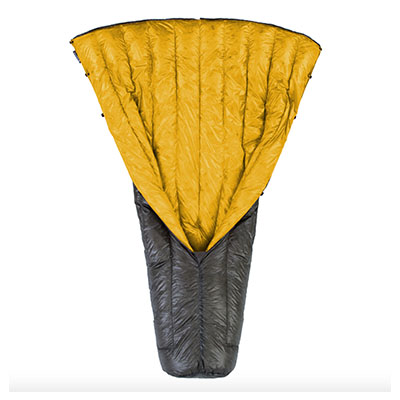
⭐⭐⭐⭐⭐
EE Enigma 10 Degree QuiltKnown for its customisability, excellent warmth-to-weight ratio, and versatility.
An excellent choice for those seeking a balance between comfort and minimal weight.
If you absolutely can’t go without a pillow, this is a great lightweight and compact option that won’t break your back.
Understanding Backpacking Sleeping Bag Weights.
Backpacking sleeping bag weight not only influences your backpack’s overall load but also impacts your comfort and warmth during the night. A good hiking sleeping bag will do both.
Let’s explore what different weights mean for different types of hikers.
The Backpacking Sleeping Bag Weight Spectrum for Backpackers
In the backpacking world, there’s a clear distinction between ‘normal’ and ‘ultralight’ hikers, each with their own set of preferences and needs.
‘Normal’ Backpackers
These are people whose adventures range from overnight stays to week-long treks or more, generally opt for sleeping bags weighing between 2 to 4 pounds / 1 to 2 kilograms.
These bags are suitable for those who prioritise a comfortable night’s sleep, those who might enjoy sleeping outside from time to time, and those who are willing to carry a bit extra weight for this luxury.
Ultralight Backpackers
These are on the other end of the spectrum. These hikers usually prefer to cover long distances, engage in more challenging treks or simply enjoy the freedom of a lighter load.
They meticulously analyse every item in their pack to shave off weight and keep their packs (and their backpacking sleep systems) feather light. For them, a sleeping bag in the range of 1 to 3 pounds / 500g to 1.5 kilograms is ideal.
Weight and Its Impact on Backpacking
Why does this weight matter so much? Well, it’s all about the trade-offs.
Heavier bags often mean more warmth and comfort when it counts, but they also mean more weight to carry throughout the day. This can be a crucial factor, especially when you’re traversing long distances or tackling challenging terrain.
With lighter bags, the goal is to minimise the load as much as possible with lighter materials and streamlined designs. Ultralight sleeping bags are crafted with feather light materials and less insulation, often sacrificing some comfort for efficiency.
As someone who’s experienced the joys and challenges of both styles, I can tell you there’s a mental ease that comes with a light pack.
The right choice greatly depends on your personal hiking style, the nature of your trip, and, quite frankly, how much you’re willing to rough it.
Key Factors in Sleeping Bag Selection.
When selecting a sleeping bag for your backpacking trip, several key factors come into play.
These elements not only affect the average backpacking weight of your sleeping bag but also determine how well it will serve you in different environments and conditions.
Health & Body Considerations
Carrying a heavy backpack for extended periods can lead to physical strain and potential injuries. As one of the heavier items in your pack, the weight of your sleeping bag contributes significantly to this.
Here’s why understanding your body and its size & shape is essential in choosing a sleeping bag:
- Injuries and Weight: Carrying a heavy backpack for extended periods can lead to physical strain and potential injuries. The weight of your sleeping bag is a substantial part of this load. Opting for a lighter bag can reduce overall weight, lessening the strain on your back, knees, and shoulders, which is vital for long-distance hikers or those with previous injuries.
- Consideration of Body Size and Shape:
- Gender-Specific Designs: Women’s sleeping bags are often wider at the hips and narrower at the shoulders, tailored to a typical female body shape. They also usually have more insulation in areas where women tend to feel colder, like the feet and torso. Men’s bags, conversely, are generally wider at the shoulders and narrower at the hips, aligning with a typical male body shape.
- Height and Build: Taller and larger individuals might need larger sleeping bags, which, in turn, can add more weight. Conversely, a sleeping bag that’s too small can restrict movement and impact insulation efficiency, leading to a less comfortable and colder night’s sleep.
- Balancing Weight with Comfort: It’s crucial to find a balance between the backpacking sleeping bag weight and your physical comfort. A bag that’s too heavy can make your hike arduous, while one that’s too light might not provide adequate warmth or fit your body comfortably.
A lighter bag can reduce the overall load, lessening the strain on your back, knees, and shoulders. This is particularly important for long-distance hikers or those with previous injuries.
Down vs Synthetic Insulation
The choice between down and synthetic insulation is a major factor in backpacking sleeping bag weight.
Down is lighter, more compressible, and offers exceptional warmth-to-weight ratio, making it a favourite among ultralight backpackers. However, it tends to be pricier and less effective when wet.
Synthetic insulation, on the other hand, is heavier and less compressible than down (read, bulkier) but performs better in damp conditions and is more budget-friendly.
Your preference for a sleeping bag for trekking may vary based on the typical weather conditions you expect to encounter and your budget constraints.
Temperature Ratings and Weight
A sleeping bag’s temperature rating directly influences its weight.
Bags designed for colder conditions (often described as 3 or 4 season bags) have more insulation (sometimes at least double), and therefore weigh more. These are often the warmest backpacking sleeping bag and might keep you feeling toasty and comfortable to as low as 0 F / -17 C!
Bags designed for summer camping (often described as 1 to 2 season bags) usually have much less insulation, or a lower loft down. They are usually the lightest backpacking sleeping bag, but will probably only be comfortable down to about 50 F / 10 C.
It’s crucial to consider the typical temperatures you’ll be facing on your hikes.
Overestimating your need for warmth can lead to carrying unnecessary weight, while underestimating can result in uncomfortably cold nights and possibly even hypothermia.
Additional Features that Impact Weight
Features like hoods, zippers, draft collars, and the overall shape of the bag (mummy sleeping bags vs. rectangular) also affect the weight.
Quilts, for instance, are becoming increasingly popular among ultralight hikers for their reduced weight and versatility. Mummy bags are more popular than rectangular bags because they reduce unnecessary fabric (and are more efficient at keeping you warm.
Features like draft collars and hoods can enhance comfort and functionality but often at the cost of added weight. It’s a balance between the features you need for comfort and the desire to keep your pack light.
The ‘Happiness’ Factor
Ultimately, the choice of sleeping bag weight ties into the ‘happiness’ factor.
A lighter weight sleeping bag can make your trek more enjoyable by reducing fatigue and increasing mobility. However, it shouldn’t compromise your comfort and warmth to the point where it detracts from your overall experience.
Finding this balance is key to a successful and enjoyable backpacking adventure.
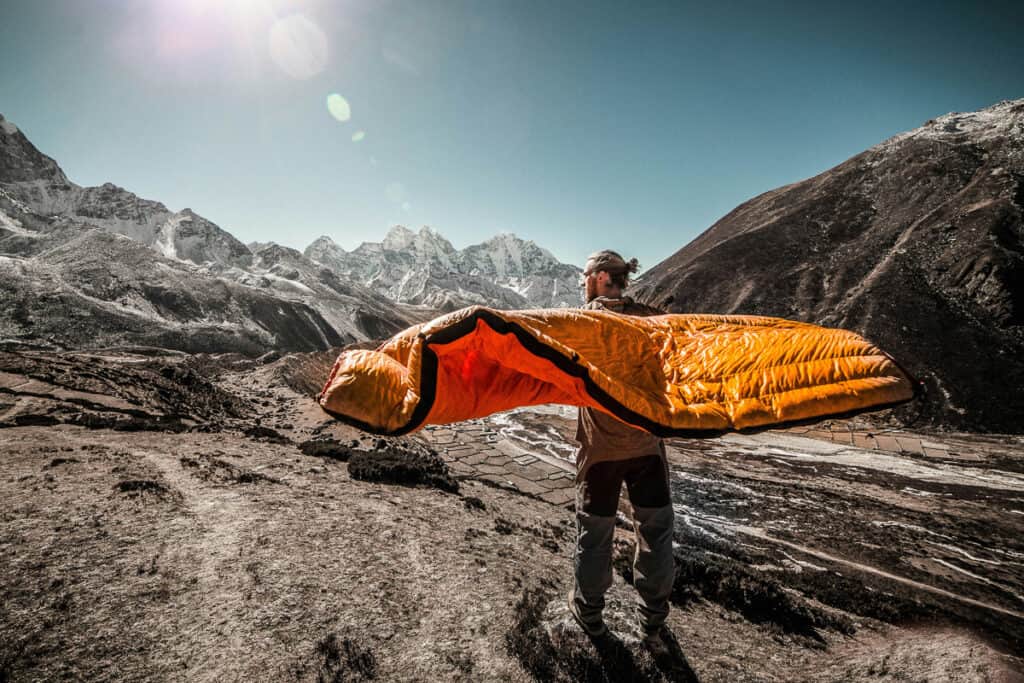
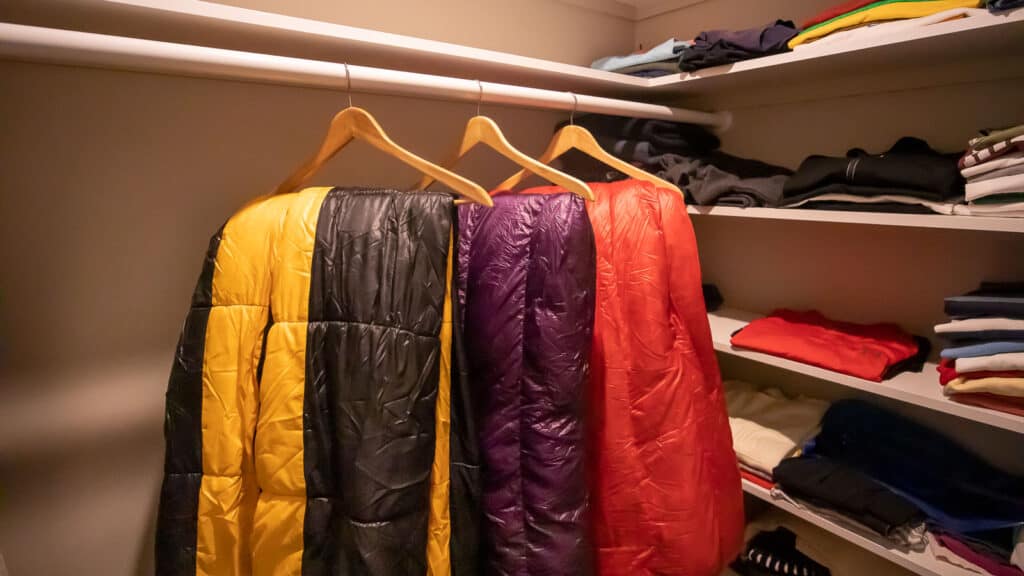
WANT A SLEEPING BAG THAT LASTS THE DISTANCE?
Discover my tips for how to store a sleeping bag like a pro.
Balancing Comfort with Weight.
The balance between comfort and weight is crucial for ensuring your backpacking trips are both enjoyable and safe.
When Lighter Isn’t Always Better
While the allure of ultralight sleeping bags is undeniable, especially when you’re facing long treks, it’s important to remember that weight savings can sometimes come at the cost of comfort and warmth.
Ultralight sleeping bags may not provide sufficient insulation in colder environments. On chilly nights, a few extra grams might make a significant difference in your comfort.
It’s essential to assess the conditions you’ll most frequently encounter and decide if a slightly heavier bag might be a worthwhile trade-off for that added warmth and comfort.
Personal Comfort vs Pack Weight
Your personal comfort is subjective. Some might prefer the snug, cosy feeling of a well-insulated bag, while others might opt for the minimalist approach.
It’s about understanding your own comfort threshold. How much are you willing to sacrifice for the sake of a lighter pack? Are you okay with a little discomfort at night for easier days on the trail? Or is a good night’s sleep crucial to your hiking experience?
Reflecting on these questions will help you find a sleeping bag that suits your specific hiking style and comfort needs.
Testing and Experience
There’s no substitute for real-world testing. If possible, try out different sleeping bags in various conditions to understand what works best for you.
Renting gear, borrowing from fellow hikers, or testing bags in outdoor stores can provide valuable insights.
Over time, as you gain more experience and knowledge about your preferences, choosing the right sleeping bag will become more intuitive.
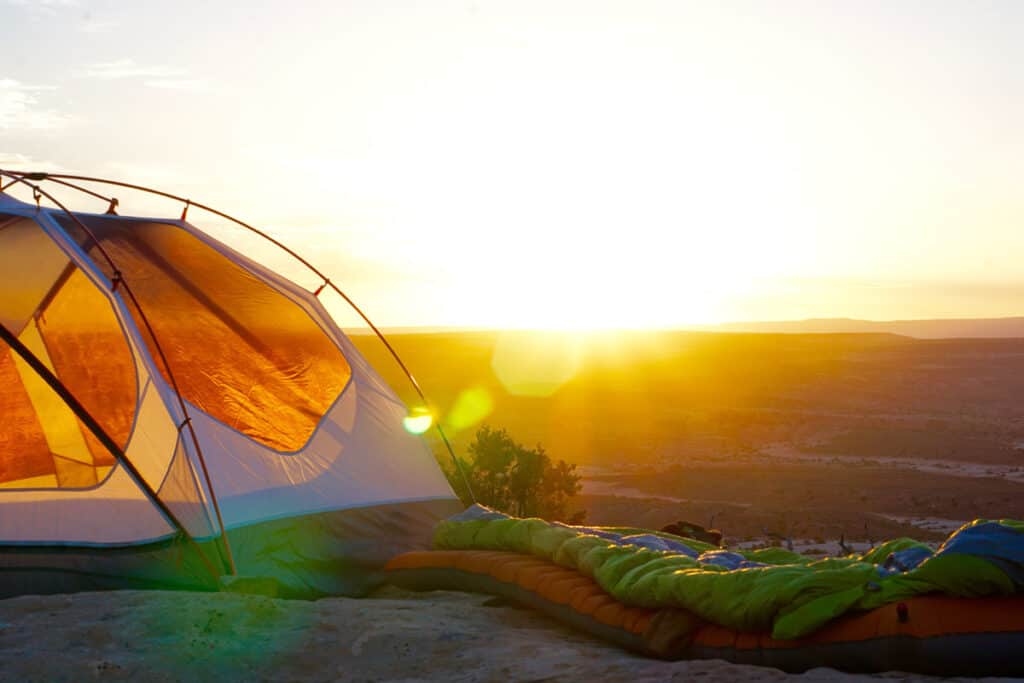
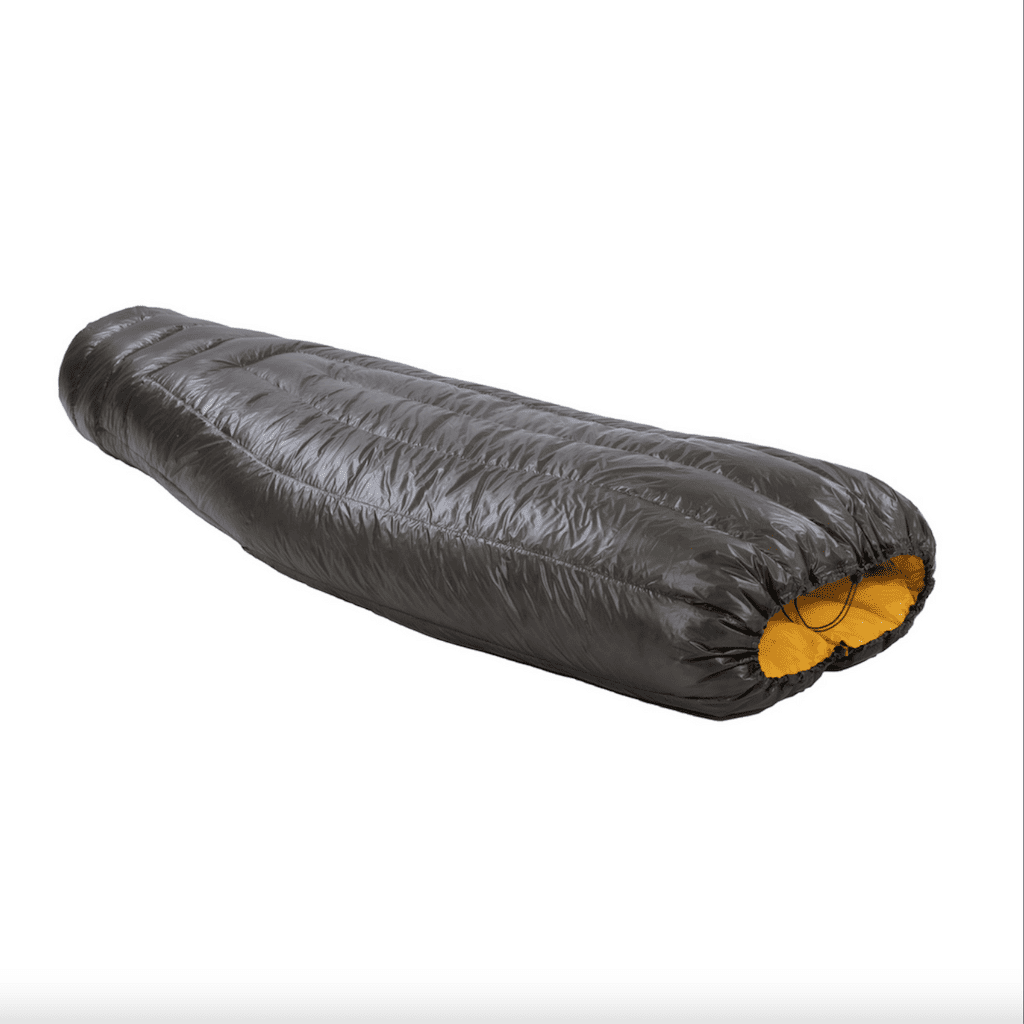
FIND OUT ABOUT THE BEST QUILT FOR BACKPACKING (IMO).
Read my comprehensive 1,000 mile review of the Enlightened Equipment Enigma Quilt.
Practical Tips for Choosing Your Sleeping Bag.
Selecting the right sleeping bag can be daunting, but with the right information and a clear understanding of your needs, you can make a choice that enhances your hiking experience.
How to choose the right sleeping bag
Here are some easy tips on how to select a sleeping bag that’s right for you:
- Assess Your Primary Hiking Conditions: Consider the usual climate and terrain of your hikes. A sleeping bag suitable for the damp, cool conditions of a forest trek might differ from one needed for dry, alpine conditions.
- Decide on the Bag’s Temperature Rating: Look for a sleeping bag with a temperature rating that aligns with the lowest temperatures you expect to encounter. Remember, it’s better to be slightly warmer than to spend a night shivering.
- Consider the Insulation Type: Choose between down and synthetic based on your budget, the expected weather conditions, and your personal preferences. Down is lighter and more compressible, ideal for dry conditions and ultralight packing. Synthetic is better for damp conditions and is typically more affordable.
- Think About Bag Shape and Features: Mummy bags are more streamlined and lighter but can be restrictive. Rectangular bags offer more room but are heavier. Quilts are an increasingly popular ultralight option. Also, consider features like hood design, zipper length, and draft collars based on your comfort preferences.
- Factor in Your Body Size: Make sure the bag fits you comfortably. A bag that’s too big can create cold spots, while one that’s too small can restrict movement and impact insulation.
Sleeping Bag Comparison chart.
To help you make an informed decision about the best backpacking sleeping bag for weight, let’s compare the sleeping bag weight kg of some popular sleeping bag models.
Sleeping Bag Comparison Chart
| Bag | Weight | Temperature (Comfort) | Fill | RRP |
| Nemo Disco 30 [ Mens ] [ Womens ] | 878g / 1lb 15oz | -1C / 30F | down (650) | USD299.95 |
| Big Agnes Sidewinder SL 20 | 1020g / 2lb 4oz | -6C / 20F | down (650) | USD299.95 |
| Sea to Summit Spark 2 | 1060g / 2lb 5oz | -1C / 30F | down (850) | USD409.00 |
| Sea to Summit Trailhead 2 | 1048g / 2lb 5oz | -1C / 30F | synthetic | USD169.00 |
| Kelty Women’s Cosmic Down 20 | 1060g / 2lb 5oz | -6C / 20F | down (550) | USD214.95 |
| Feathered Friends Hummingbird | 680g / 1lb 8oz | -6C / 20F | down (950) | USD609.00 |
| Therm-a-Rest Parsec 20 | 810g / 1lb 12oz | -6C / 20F | down (800) | USD499.95 |
| The North Face Blue Kazoo Eco | 964g / 2lb 2oz | -4C / 25F | down (700) | USD320.00 |
| Mountain Hardwear Phantom 15F | 941g / 2lb 1oz | -9C / 15F | down (850) | USD580.00 |
| Enlightened Equipment Enigma 10 Degree Quilt | 692g / 1lb 8oz | -12C / 10F | down (850) | USD355.00 |
| Feathered Friends Swallow UL 20 | 476g / 1lb 1oz | -6C / 20F | down (950) | USD629.00 |
| Marmot Trestles Elite Eco 30 | 850g / 1lb 14oz | -1C / 30F | synthetic | USD169.00 |
| Marmot Trestles Elite Eco 20 | 1077g / 2lb 6oz | -6C / 20F | synthetic | USD169.00 |
| Western Mountaineering Ultralite | 822g / 1lb 13 oz | -6C / 20F | down (850) | USD620.00 |
| Western Mountaineering Highlite | 453g / 1lb | 1.5C / 35F | down (850) | USD435.00 |
| Macpac Standard Azure 700 | 1300g / 2lb 14oz | -4C / 25F | down (700) | NZD749.99 |
| Macpac Standard Dragonfly 600 | 981g / 2lb 3oz | -10C / 15F | down (600) | NZD849.99 |
| Enlightened Equipment Enigma Apex | 811g / 1lb 12oz | -6C / 20F | synthetic | USD250.00 |
| Patagonia Fitz Roy | 822g / 1lb 13oz | -1C / 30F | down (800) | USD429.00 |
| Feathered Friends Tanager | 527g / 1lb 2.6oz | -6C / 20F | down (950) | USD469.00 |
| Thermarest Hyperion 20 | 566g / 1lb 4oz | -6C / 20F | down (900) | USD549.95 |
| Nemo Forte Endless Promise 20 [ Mens ] [ Womens ] | 907g / 2lb | -6C / 20F | synthetic | USD219.95 |
Tips for a Lightweight Sleep System.
Maximising the efficiency of your sleep system is crucial for a comfortable and lightweight backpacking experience.
Here are some tips to help you reduce the weight of your sleeping setup without compromising comfort.
Strategies for Weight Reduction
- Opt for a Lightweight Sleeping Bag: Choose the lightest sleeping bag that meets your warmth needs. Consider ultralight options, especially for summer or mild weather backpacking.
- Consider a Sleeping Quilt: Quilts are becoming increasingly popular in the ultralight community. They offer a great weight-to-warmth ratio and can be more versatile than traditional sleeping bags.
- Select an Ultralight Sleeping Pad: A lightweight sleeping pad like the Therm-a-Rest NeoAir XLite (Women’s) provides necessary insulation and comfort without adding much weight. Remember, the pad is as important as the bag for warmth.
- Ditch the Pillow: Instead of a pillow, consider using a stuff sack filled with clothes or a specially designed ultralight camping pillow.
- Layer Your Clothing: Wearing a base layer to bed can add warmth, allowing you to choose a lighter bag. Just ensure the clothing is dry and clean to maintain insulation efficiency.
- Evaluate Every Item: Go through your sleeping system and evaluate if each item is necessary and if there is a lighter alternative available.
Conclusion: How Much Should A Backpacking Sleeping Bag Weigh?
The ideal weight for a backpacking sleeping bag generally falls between 2 to 4 pounds (0.9 to 1.8 kilograms) for most backpackers and 1 to 3 pounds (0.45 to 1.36 kilograms) for those preferring an ultralight approach.
Remember, it’s all about balancing your pack’s weight with your comfort and warmth needs. This sweet spot is unique for every hiker, shaped by personal preferences, hiking style, and the environment you’ll be exploring.
Now that you’re equipped with the know-how on sleeping bag weights, why stop there? Dive deeper into the world of backpacking sleeping essentials with my other resources:
- Wondering about the best ways to keep your sleeping bag in top-notch condition? My post on How to Store a Sleeping Bag is a treasure trove of tips to prolong the life of your gear.
- If you’re intrigued by the idea of ultralight backpacking and keen on real-world gear reviews, don’t miss my in-depth look at the Enlightened Equipment Enigma.
- Plus, join me on my YouTube channel where I reveal why I’ve made a permanent switch to a quilt system, and how it’s transformed my backpacking experience.


